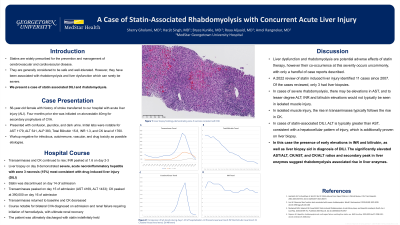Tuesday Poster Session
Category: Liver
P3983 - A Case of Statin-Associated Rhabdomyolysis and Acute Liver Injury
Tuesday, October 24, 2023
10:30 AM - 4:00 PM PT
Location: Exhibit Hall

Has Audio

Sherry Gholami, MD
MedStar Georgetown University Hospital
Washington, DC
Presenting Author(s)
Sherry Gholami, MD, Harjit Singh, MD, Bryce Kunkle, MD, Amol S. Rangnekar, MD
MedStar Georgetown University Hospital, Washington, DC
Introduction: Statins are widely prescribed medications for primary or secondary prevention of cerebrovascular accidents and cardiovascular disease. They are generally considered to be safe and well-tolerated. However, they have been associated with rhabdomyolysis as well as liver dysfunction which can rarely be severe.
Case Description/Methods: A 56-year-old female with no history of liver disease was transferred to our medical center for management of acute liver injury (ALI). She presented with confusion and jaundice and initial labs were notable for AST 1179, ALT 541, ALP 383, Total Bilirubin 15.8, INR 1.3. Workup was negative for infectious, autoimmune, vascular, and drug toxicity as possible etiologies. There was no history of significant alcohol use, drug use, or recent travel. Four months prior she was initiated on atorvastatin 40mg for secondary prophylaxis of CVA.
The patient’s serum liver associated enzymes and INR continued to increase. A CK level was elevated at 316,000 and peaked at 390,000. Liver biopsy performed 5 days prior to statin discontinuation demonstrated severe, acute necroinflammatory hepatitis with zone 3 necrosis (15%) most consistent with drug induced liver injury (DILI). Her statin was discontinued due to concern for statin associated rhabdomyolysis and DILI. The patient’s serum liver associated enzymes peaked at AST 4169, ALT 1433, ALP 397, two days after statin discontinuation.
Acute liver injury was thought to be related to statin associated DILI and statin-induced rhabdomyolysis. Her statin was discontinued indefinitely, and liver function returned to baseline. Her hospital course was otherwise complicated by acute kidney failure requiring initiation of hemodialysis.
Discussion: ALI and rhabdomyolysis are both potential adverse effects of statin therapy. In cases of statin-associated DILI, ALT is typically greater than AST, consistent with a hepatocellular pattern of injury. Rhabdomyolysis is associated with elevated AST greater than ALT and higher CK/ALT and CK/AST ratios, as seen in this case. Coagulation markers and bilirubin can be used to differentiate between elevated aminotransferases due to rhabdomyolysis versus ALI. In this case the presence of elevated INR and bilirubin, as well as liver biopsy findings suggest DILI, while the significantly elevated AST/ALT, CK/AST, and CK/ALT ratios suggest concurrent rhabdomyolysis, demonstrating a unique and multifactorial case of ALI.
Disclosures:
Sherry Gholami, MD, Harjit Singh, MD, Bryce Kunkle, MD, Amol S. Rangnekar, MD. P3983 - A Case of Statin-Associated Rhabdomyolysis and Acute Liver Injury, ACG 2023 Annual Scientific Meeting Abstracts. Vancouver, BC, Canada: American College of Gastroenterology.
MedStar Georgetown University Hospital, Washington, DC
Introduction: Statins are widely prescribed medications for primary or secondary prevention of cerebrovascular accidents and cardiovascular disease. They are generally considered to be safe and well-tolerated. However, they have been associated with rhabdomyolysis as well as liver dysfunction which can rarely be severe.
Case Description/Methods: A 56-year-old female with no history of liver disease was transferred to our medical center for management of acute liver injury (ALI). She presented with confusion and jaundice and initial labs were notable for AST 1179, ALT 541, ALP 383, Total Bilirubin 15.8, INR 1.3. Workup was negative for infectious, autoimmune, vascular, and drug toxicity as possible etiologies. There was no history of significant alcohol use, drug use, or recent travel. Four months prior she was initiated on atorvastatin 40mg for secondary prophylaxis of CVA.
The patient’s serum liver associated enzymes and INR continued to increase. A CK level was elevated at 316,000 and peaked at 390,000. Liver biopsy performed 5 days prior to statin discontinuation demonstrated severe, acute necroinflammatory hepatitis with zone 3 necrosis (15%) most consistent with drug induced liver injury (DILI). Her statin was discontinued due to concern for statin associated rhabdomyolysis and DILI. The patient’s serum liver associated enzymes peaked at AST 4169, ALT 1433, ALP 397, two days after statin discontinuation.
Acute liver injury was thought to be related to statin associated DILI and statin-induced rhabdomyolysis. Her statin was discontinued indefinitely, and liver function returned to baseline. Her hospital course was otherwise complicated by acute kidney failure requiring initiation of hemodialysis.
Discussion: ALI and rhabdomyolysis are both potential adverse effects of statin therapy. In cases of statin-associated DILI, ALT is typically greater than AST, consistent with a hepatocellular pattern of injury. Rhabdomyolysis is associated with elevated AST greater than ALT and higher CK/ALT and CK/AST ratios, as seen in this case. Coagulation markers and bilirubin can be used to differentiate between elevated aminotransferases due to rhabdomyolysis versus ALI. In this case the presence of elevated INR and bilirubin, as well as liver biopsy findings suggest DILI, while the significantly elevated AST/ALT, CK/AST, and CK/ALT ratios suggest concurrent rhabdomyolysis, demonstrating a unique and multifactorial case of ALI.
Disclosures:
Sherry Gholami indicated no relevant financial relationships.
Harjit Singh indicated no relevant financial relationships.
Bryce Kunkle indicated no relevant financial relationships.
Amol Rangnekar indicated no relevant financial relationships.
Sherry Gholami, MD, Harjit Singh, MD, Bryce Kunkle, MD, Amol S. Rangnekar, MD. P3983 - A Case of Statin-Associated Rhabdomyolysis and Acute Liver Injury, ACG 2023 Annual Scientific Meeting Abstracts. Vancouver, BC, Canada: American College of Gastroenterology.
